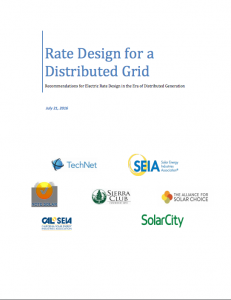Full Title: Rate Design for a Distributed Grid: Recommendations for Electric Rate Design in the Era of Distributed Generation
Author(s):
Publisher(s): SEIA, TechNet, Sierra Club, Vote Solar, The Alliance for Solar Choice, CalSEIA and SolarCityPublication Date: 07/2016
Publication Date: July 1, 2016
Full Text: Download Resource
Description (excerpt):
In response to the growing popularity of rooftop solar and other distributed energy resources (DERs), some electric utilities have recently begun seeking ratemaking changes that would discourage customers from generating their own power and otherwise buying less electricity from their utility. These changes – which include higher fixed charges and reduced compensation for exported energy – are justified by a purported concern about costs being shifted among customers of the same rate class. The utilities ratemaking ideas are often expressed by the Edison Electric Institute (EEI), most recently in a rate design “Primer” sent to the National Association of Regulatory Utility Commissions (NARUC).
Published by a coalition of partners, including SEIA, TechNet, Sierra Club, Vote Solar, The Alliance for Solar Choice, CalSEIA and SolarCity, this paper responds to EEI first by examining the allegation that rooftop solar shifts costs onto other utility customers. We point out that the assumption of a cross-subsidy rests largely on the premise that self-generation provides no benefit to the utility and its ratepayers other than reducing the short-run cost to buy or generate power. To the contrary, we show that rooftop solar provides a wide range of benefits, including avoided generation, transmission and distribution capacity, lower wholesale market prices, reduced volatility, and avoided pollution. We also offer some rate design principles aimed at achieving broad ratepayer and societal benefits and a series of reforms that could better integrate DERs into the electric grid and maximize their value to ratepayers.
